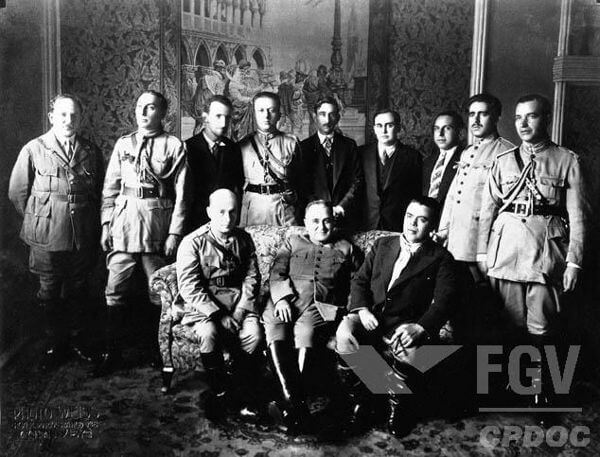What was ALN – Ação Libertadora Nacional?
THE National Liberating Action, also known by the acronym ALN, was one of the communist-oriented revolutionary factions that operated in Brazil during the period of regimenMilitary (1964 to 1985). Using urban guerrilla methods, such as assaults, kidnappings and terrorist actions, the ALN, whose main commander Carlosmarighella, was formed in 1968 from a dissent from the Brazilian Communist Party (PCB). In addition to Marighella, two other important faction commanders were Carlos Joaquim Câmara Ferreira and Carlos Eugenio da Paz.
ALN Origin
Carlos Marighella and Joaquim Câmara Ferreira were former members of the Brazilian Communist Party. In 1967, after the creation of hello, Latin American Solidarity Organization, on the part of Cuba, in which Marighella participated in the first conference, perspectives different from those of the PCB appeared. OLAS proposed to “export” the revolution (which until then had been “successful” in Cuba) to all of Latin America. One of the strategic proposals for this was the "
revolutionary focus theory”, elaborated by Ernesto “Che” Guevara and Debray Regis, which preached the installation of several guerrilla centers on the continent, in order to take power from them.Marighella, Joquim Câmara Ferreira and other members of the PCB, influenced by Cuban theorists, decided to break with the democratic legalist perspective of the party and form a dissent, with a view to the immediate start of the fight armed. The nucleus of this dissidence was born in 1967, in São Paulo, under the name of “Statement by the communist group from São Paulo”. In 1968, it assumed the name of Ação Libertadora Nacional.
It is noteworthy that the perspective of installing revolutionary focuses of communist orientation, with a view to the seizure of power in Brazil was not exclusive to the ALN and also predated the 1964 military coup itself. In 1963, militants of the PC do B (Communist Party of Brazil) and AP (Popular Action) received military training in the Beijing Military Academy, in China – a country that had also made its revolution within the communist perspective, and that had similar revolutionary focus strategies to those of “Che” Guevara.
Terrorism according to ALN
One of the forerunners of 20th century revolutionary strategies, the Bolshevik vladimirLenin, faced the practice of terrorism as “the armed propaganda of the Revolution”. Terrorist actions have always been related to revolutionary activities, whether anarchist, communist or nationalist. The ALN, in its program, made it clear that: “We are all guerrillas, terrorists and robbers and not men who they depend on the votes of other revolutionaries or anyone else to fulfill the duty of doing the revolution".
Carlos Marighella, who wrote the Urban Guerrilla Mini-Manual (booklet read by communist factions from various parts of the world), developed a whole topic advocating the practice of terrorism as a decisive “weapon” for the revolutionary. Below is what is written in the topic:
Terrorism is an action, usually involving the placing of a bomb or a fire bomb of great destructive power, which is capable of influencing irreparable losses to the enemy.
Do not stop now... There's more after the advertising ;)
Terrorism requires urban guerrillas to have a theoretical and practical knowledge of how to make explosives.
The act of terrorism, apart from the apparent ease in which it can be carried out, is no different from other acts of the urban guerrilla and actions in which the triumph depends on the plan and determination of the organization revolutionary. It is an action that the urban guerrillas must carry out with great calm, decision and cold blood.
Although terrorism usually involves an explosion, there are cases in which the execution or systematic fire of US facilities, property and warehouses, farms, etc. can be carried out. It is essential to point out the importance of fires and the construction of incendiary bombs such as gasoline bombs in the technique of revolutionary terrorism. Another important thing is the material that urban guerrillas can persuade the people to expropriate in times of famine and scarcity, the result of large commercial interests.
Terrorism is a weapon that the revolutionary cannot abandon.
This characteristic of terrorism as an activity intrinsic to urban guerrilla warfare was at the heart of the ALN's revolutionary proposal.
The "Revolutionary Democracy"
In the excerpt above, where we quoted a sentence from the ALN program, we noticed the emphasis given to the fact that its members do not "they depend on the votes of other revolutionaries or anyone else to carry out the duty of doing the revolution". This excerpt mentions the perspective of “democracyrevolutionary”, preached by the group, which went against the “centralismdemocratic” developed by the Bolsheviks during the Russian Revolution and incorporated by the PCs (Communist Parties) from other regions of the world. Democratic centralism postulated that all activities linked to the Communist Party, such as the formation of "cadres", that is, party militants, the organization administrative, elections for leaders, etc., should be centralized, and should be debated and voted on, before the party takes a proper perspective. revolutionary.
Against this, the ALN advocated immediate revolutionary armed action. Such action, in the form of guerrilla warfare, should gradually gain the adhesion of the urban and rural masses. This, according to the faction, was “revolutionary democracy”.
ALN Action
The main actions carried out by the ALN during the period in which the faction was active (1968 to 1968) were: o robbery of the paying train on the Jundiaí-São Paulo line (in which Marighella himself was ahead), the participation in the kidnapping of ambassador Charles Elbrick, planned by the group Guanabara Communist Dissidence, O murder of businessman Henning Boilesen (who was a collaborator of the OBAN – Operation Bandeirante –, repression agency of the Military Regime) and the murder of ALN's own militant, Márcio Toledo, considered a traitor to the faction.
By Me. Cláudio Fernandes

